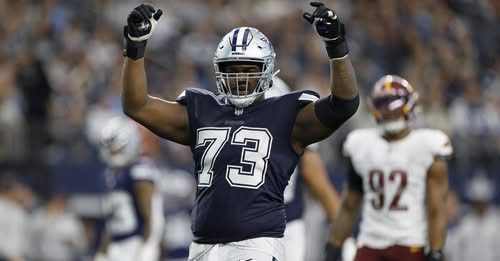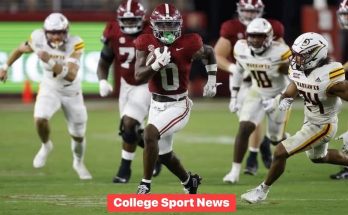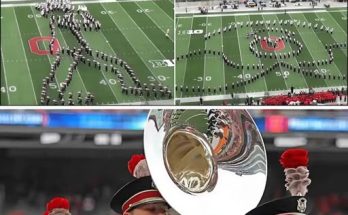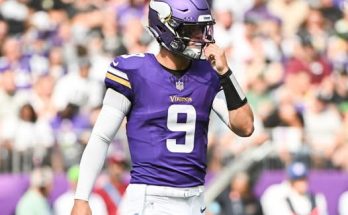Tyler Smith, the talented and steadily ascending offensive lineman for the Dallas Cowboys, has stirred conversation heading into the 2025 NFL season with one bold but clear proclamation: winning the Super Bowl is a “realistic goal” for this team. These words, uttered not with arrogance but with a sense of calm confidence and steely resolve, encapsulate a new energy emanating from a franchise that hasn’t hoisted the Lombardi Trophy since the 1995 season. In a league dominated by parity, where winning windows can open and close in a flash, Tyler Smith’s outlook reflects not just hope but a calculated belief based on evidence, cohesion, and growth—something that has been carefully nurtured in Dallas over recent years.
Smith is no stranger to pressure. Drafted in the first round in 2022, the former Tulsa standout arrived in Dallas with high expectations. The Cowboys were not just looking for a reliable lineman; they were seeking the future cornerstone of an offensive line lineage long defined by greatness. From the days of Larry Allen to Tyron Smith, the Cowboys have always taken pride in building a strong front, and Tyler Smith was expected to carry that mantle. Three years later, he has not only met those expectations but often surpassed them, showing positional flexibility, brute strength, and cerebral instincts rare for someone his age. His development has mirrored that of the team itself: gradual, focused, and increasingly dominant.
So when Smith states that a Super Bowl victory is not a pipe dream but a tangible target, it’s worth dissecting the larger context of his claim. Because, in truth, his words may carry more weight than most are willing to admit.
To start, the Cowboys are coming off consecutive playoff appearances and have built a robust, well-rounded roster. While their 2024 campaign ended earlier than hoped—falling short once again in the Divisional Round—it was not for lack of talent or effort. Statistically, they ranked among the league’s top ten in both offense and defense. Dak Prescott, often the lightning rod for both praise and criticism, had one of his most efficient seasons to date, cutting down on turnovers and displaying impressive leadership under pressure. Despite missing a few key opportunities in big moments, the team’s offensive nucleus is both intact and maturing.
More importantly, the 2025 season offers something even more crucial: continuity. This is a word often thrown around in football circles, but its importance cannot be overstated. In an environment where coaching staffs change like the wind and roster overhauls are the norm, maintaining a core group year-over-year is a luxury. The Cowboys benefit from this rare stability. Head coach Mike McCarthy, despite facing intense scrutiny at times, returns with the vote of confidence from ownership and players alike. Offensive coordinator Brian Schottenheimer has another year to deepen the playbook’s rhythm with Dak Prescott. And defensively, new DC Mike Zimmer has instilled an old-school grit that the players are responding to after replacing Dan Quinn. These pieces, while familiar, are evolving in ways that make them more dangerous than ever.
Tyler Smith’s offensive line unit is central to this transformation. A good football team can’t function without a solid offensive line. A great team, the kind that wins in January and February, needs a dominant one. In Smith, Dallas has the ideal combination of strength, mobility, and intelligence. But it’s not just him. The return of a healthy Tyler Biadasz at center, the veteran presence of Zack Martin, and the development of younger players like Asim Richards have fortified the trenches in a way that could be game-changing. If this unit can stay healthy, Dallas can impose its will on both sides of the ball.
The schedule for the 2025 season isn’t a walk in the park, but that’s never the case in the NFL. However, the Cowboys have shown they can beat quality opponents, especially when playing mistake-free football. One thing that sets this year’s team apart is its growing ability to win in different ways. They can air it out when needed, especially with CeeDee Lamb blossoming into a top-five receiver and Brandin Cooks stretching the field. But they can also grind down defenses with a physical run game, led by Tony Pollard and bolstered by an increasingly creative use of tight ends in blocking and short-yardage situations. The offense can morph week-to-week, and that versatility will be key when facing playoff-caliber defenses.
On defense, the Cowboys are led by the ever-ascendant Micah Parsons, who may well be the most disruptive force in the league. With the addition of depth at defensive tackle and the continued excellence of Trevon Diggs and DaRon Bland in the secondary, Dallas has the pieces to slow down even the most potent offenses. More crucially, they’ve built a culture of accountability and aggression. This is not the same Cowboys team that relied on shootouts to win. This group can go toe-to-toe in a defensive slugfest and come out on top. And that’s the kind of edge you need to make a deep playoff run.
But making the leap from a playoff team to a Super Bowl champion involves more than talent. It demands resilience, maturity, and a killer instinct that has often been missing in Dallas since the 90s dynasty years. Tyler Smith’s statement can thus be seen not just as a reflection of optimism but a signal that this team is mentally evolving. It’s not enough to want to win—you have to believe you can. You have to internalize the belief so deeply that every practice rep, every offseason decision, every rehab session after an injury, is done with the singular purpose of hoisting the Lombardi. Smith’s mindset suggests that the Cowboys are getting there.
Another factor working in Dallas’ favor is the current landscape of the NFC. While the Philadelphia Eagles remain formidable, their aging defensive line and recent turnover in the secondary have introduced new vulnerabilities. The San Francisco 49ers, while still a juggernaut, continue to wrestle with questions at quarterback durability. Green Bay is rising with Jordan Love, but they may be a year or two away from peaking. Dallas, by contrast, is both experienced and hungry. Their window is wide open—and they know it.
Of course, any discussion of Dallas and championships will bring out the skeptics. The Cowboys haven’t been to an NFC Championship Game since the 1995 season. Every promising year since then has ended in disappointment—some in shocking fashion. The legacy of underachievement looms large over the franchise. But it’s also a burden today’s players seem less burdened by. The likes of Tyler Smith, Micah Parsons, and CeeDee Lamb weren’t even born the last time the Cowboys won it all. They don’t carry the weight of past failures. They only see what’s in front of them: a realistic, attainable goal.
This shift in mentality is perhaps the most telling change of all. When younger leaders like Smith speak about winning the Super Bowl with matter-of-fact realism, it reveals a broader organizational belief. They’re not here to entertain the idea. They’re here to make it real. And in football, belief—true, deeply-held conviction—is often the precursor to greatness.
The Cowboys’ front office has also done its part in ensuring the team is equipped to contend. For years, fans criticized Jerry Jones for meddling or being too sentimental with player decisions. But recent offseasons have shown a more pragmatic, forward-thinking approach. Re-signing key players early, maintaining cap flexibility, and using the draft to build sustainable depth has become the new standard. Tyler Smith himself is a product of this approach—a high-upside player with long-term value, taken at a time when many draft analysts questioned the pick. The result? A lineman who could anchor this team for a decade or more.
And then there’s the intangible of hunger. Smith and his teammates are not satisfied with division titles or regular-season accolades. The disappointment of early playoff exits burns deeply, and it’s fueling a higher level of preparation. Reports from training camp indicate a sharper focus, fewer mental mistakes, and more intense competition across position groups. Players are pushing each other harder, and there’s less tolerance for complacency. That kind of internal accountability is often what separates good teams from legendary ones.
Ultimately, the NFL is a results-driven business. Tyler Smith can say whatever he wants, but fans will only believe it when they see confetti falling in February. Yet his statement should not be dismissed as offseason fluff. It should be recognized as a moment of emerging leadership from a player whose development mirrors the trajectory of the team. When your offensive lineman is speaking with this level of vision, it means something’s clicking—not just on the field, but within the culture of the organization.
Whether the Cowboys win it all in 2025 remains to be seen. Injuries, bad bounces, or a freak performance from an opponent can derail even the most talented squads. But what makes this team different is that their ceiling isn’t hypothetical anymore. It’s visible. Achievable. Real. Tyler Smith sees it. And more importantly, he believes his team is ready to claim it.
There’s an old adage in football: games are won in the trenches. If that holds true in 2025, then Dallas has every reason to believe. With Tyler Smith leading the charge up front—physically, emotionally, and vocally—the Cowboys may just be ready to end a three-decade-long drought and finally return to the NFL’s mountaintop. Because sometimes, all it takes is one player to say it out loud for an entire team to begin walking like champions. And maybe, just maybe, that player was Tyler Smith.



